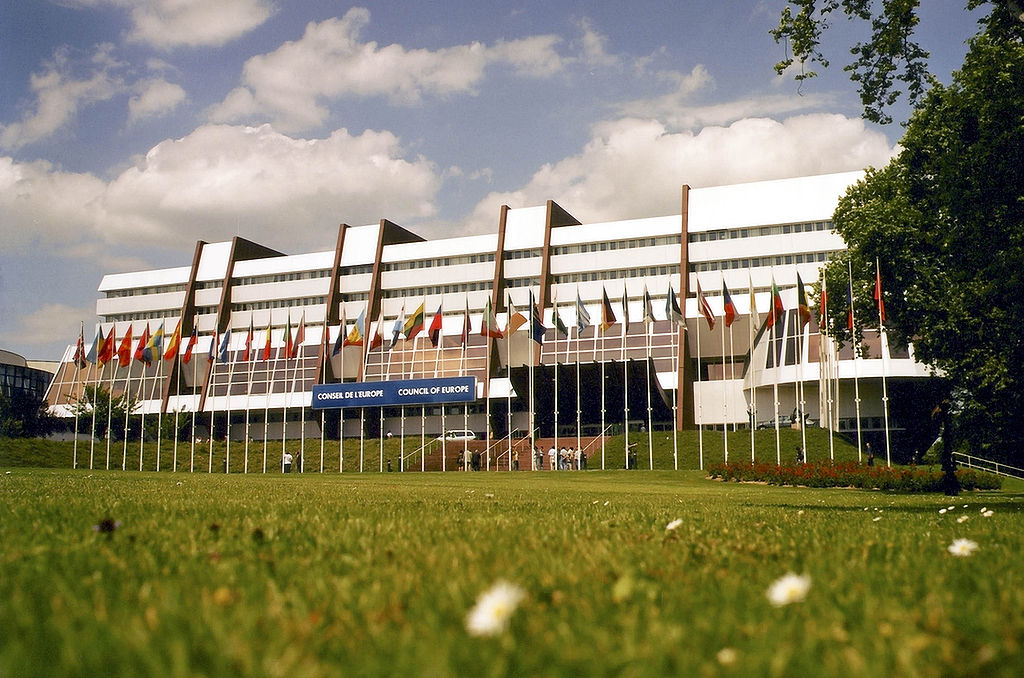The Council of Europe’s Parliamentary Assembly Takes on the Legal Challenges of Hybrid Warfare
Over the last few years, “hybrid warfare” has become firmly established in the Western security lexicon. The concept features prominently in NATO and EU policy instruments and has informed the United States’ National Security Strategy adopted in December 2017. (I analyzed this idea in more depth here.)

Published by The Lawfare Institute
in Cooperation With

Over the last few years, “hybrid warfare” has become firmly established in the Western security lexicon. The concept features prominently in NATO and EU policy instruments and has informed the United States’ National Security Strategy adopted in December 2017. (I analyzed this idea in more depth here.)
Despite the term’s frequent appearance in policy documents, international legal instruments so far have avoided it. Resolution 2217—adopted by the Parliamentary Assembly of the Council of Europe on March 26—bucks this trend. The resolution is a formal instrument issued by the deliberative organ of an international organization making certain nonbinding recommendations to the organization’s member-states regarding the legal challenges presented by hybrid warfare. As such, it merits a closer look. (Readers may also be interested in the report on which the resolution is based.)
Definition and legal dynamics of hybrid warfare
The opening paragraphs of Resolution 2217 recall some of the Parliamentary Assembly’s earlier resolutions, including Resolution 2133 from 2016. This preceding resolution reaffirms the assembly’s position that Russia’s annexation of Crimea and its intervention in eastern Ukraine violate international law. This reference and others leave little doubt about the political background against which Resolution 2217 was adopted.
The Parliamentary Assembly defines hybrid warfare as a “threat based on a combination of military and nonmilitary means,” reflecting the mainstream understanding of the concept. The resolution notes that the increasingly widespread use of hybrid tactics, such as cyberattacks, disinformation campaigns and interference in elections, raises concerns “about the adequacy of existing legal norms.” Developing this theme further, the text identifies the underlying legal dynamics of hybrid warfare as “legal asymmetry”—hybrid adversaries typically seek to exploit legal thresholds, gray areas and complexity in order to escape the legal consequences of their actions.
Nonetheless, the assembly stresses that hybrid adversaries do not operate in a legal vacuum. Relevant rules of domestic and international law, including international human-rights law, apply to their actions. The assembly specifically confirms that, in the context of a hybrid war, when a state resorts to the use of force against another state, the latter is entitled to invoke the inherent right of self-defense enshrined in Article 51 of the U.N. Charter. In this, the Parliamentary Assembly follows the North Atlantic Council, which in its July 9, 2017 Warsaw Summit Communiqué declared that NATO is “prepared to counter hybrid warfare as part of collective defence,” including by invoking Article 5 of the North Atlantic Treaty. This position is not remarkable. The right of individual and collective self-defense applies irrespective of the type of weapon used to conduct an armed attack. What matters is the scale and effect of the attack, not the means by which it is carried out. A hybrid attack that employs a combination of military and nonmilitary instruments triggers the right of self-defense, provided that its scale and effects are analogous to those of a conventional armed attack.
Hybrid legal regimes for hybrid threats?
The Parliamentary Assembly notes that “in cases in which a hybrid adversary refrains from the use of military means, its actions should be examined in the light of domestic criminal law.” Presumably, the assembly’s point is that hybrid tactics not involving military means should be handled as a matter of law enforcement; it is unlikely that the assembly meant to suggest that nonmilitary threats should be subject to domestic law exclusively. But hybrid threats are, as the name suggests, hybrid in character. The defining feature of hybrid warfare is that it seeks to achieve operational effects through the combination of conventional and unconventional, military and nonmilitary means. The “little green men” of Crimea and the use of Chinese coast guard and fishing vessels in the South China Sea are classic examples of this tactic.
Consequently, should a hybrid adversary employ nonmilitary means to achieve military effects, law enforcement measures may be inadequate. Moreover, what matters from a human rights perspective is that the means employed to meet a particular threat are necessary and proportionate, irrespective of whether they are military in nature. For example, the fact alone that Russia deployed military units during the Beslan school siege in 2004 did not contravene the European Convention on Human Rights. As the European Court held in the case of Tagayeva, it was the indiscriminate use of certain weapons and tactics by those units that fell afoul of the convention, not their military character itself.
The resolution thus fails to acknowledge one of the principal legal challenges facing states: How should states counter hybrid or multimodal tactics, such as those in the South China Sea, with agencies, procedures and doctrines that are geared towards conventional threats and based on the traditional distinction between law enforcement and warfighting? Finland, for example, has recently amended its Territorial Surveillance Act, which serves as the legal framework for safeguarding Finland’s territorial integrity. An earlier version of the act required the Finnish armed forces and border guard to take appropriate steps against unauthorized intrusions by foreign military personnel, units, vehicles, aircrafts and vessels. Section 2 of the law defined foreign “military persons” as armed or unarmed members of national armed forces. In 2017, the law was amended to cover groups that are militarily organized, equipped or armed, and comparable to forces operating on behalf of, for or with the consent of a foreign state, but whose national origin cannot be identified. As a result, the Finnish military authorities are now empowered to take appropriate action against armed formations not wearing regular military uniform or other symbols of nationality.
The new resolution also recalls that states are bound to respect human rights law in their efforts to counter hybrid warfare, especially in the case of the deliberate spread of disinformation. A number of states are grappling with this issue. The French National Assembly, for instance, is in the process of considering draft legislation on the fight against false information. The draft imposes an obligation on digital platforms to be more transparent about sponsored content during election periods and introduces a summary judicial procedure to compel content providers to terminate the dissemination of false information. The draft also increases the powers of the French audio-visual licensing authority to curtail or deny the operation of broadcasting services when they are contrary to “public order” or the “fundamental interests” of France. As the proposal notes, measures to fight the spread of disinformation must be weighed against the freedom of expression. However, the regulatory challenge is not merely to appropriately balance national security and human rights, but also to devise appropriate legal concepts and mechanisms that distinguish disinformation from information without being over- or underinclusive. Some useful pointers may be found in the jurisprudence of the European Court, which has distinguished between facts (which are capable of validation) and value-judgements (which are unfalsifiable).
Recommendations
Resolution 2217 describes a number of recommendations worthy of quoting in full:
10. Therefore, the Assembly calls on member States to:
10.1. refrain from resorting to hybrid war in international relations and fully respect the provisions of international law, in particular the principles of sovereignty, territorial integrity and inviolability of frontiers, in accordance with their object and purpose, by not abusively exploiting perceived loopholes or ambiguities;
10.2. step up international co-operation in order to identify hybrid war adversaries and all types of hybrid war threats, as well as to establish the applicable legal framework;
10.3. maintain exchange of information regarding hybrid aggressions in Europe and share experience and good practice in countering hybrid threats;
10.4. take measures to increase the public’s awareness of hybrid war threats and its ability to react speedily to such threats;
10.5. implement the Council of Europe Convention on Cybercrime (ETS No. 185), sign and ratify it where this is not already the case, and promote its ratification by non-member States.
What should we make of these recommendations? Despite their simple language, some of them conceal profound difficulties. The integrated use of the full range of coercive means available to states is not a breach of international law, but sound statecraft. Accordingly, if hybrid warfare is understood as a mere synonym for the comprehensive approach, it becomes difficult to distinguish what the resolution calls “hybrid war adversaries” from law-abiding members of the international community. Most, if not all, states engage in hybrid warfare defined as the comprehensive approach. Such a broad definition strips the concept of hybrid warfare of any distinct meaning. A more meaningful definition could include an additional element: the abuse of law. This, however, raises the rather difficult question as to how one distinguishes between the legitimate use of the law for national security purposes and its abuse at the hands of “hybrid war adversaries.” In some circumstances, such as those involving illegal territorial annexations, the answer should be straightforward. In others, it may be less so. For example, measures that curtail the freedom of expression in the name of fighting the spread of disinformation are likely to turn on some rather delicate legal and policy distinctions.
This is not to say that meaningful distinctions between the use and abuse of the law cannot be drawn. The point, rather, is that drawing these distinctions involves the exercise of judgment. Resolution 2217 is therefore right to welcome co-operation between the EU and NATO in this field and to call for the sharing of best practices. Initiatives such as the legal-resilience network launched by the European Centre of Excellence for Countering Hybrid Threats are vital for raising awareness about the legal challenges presented by hybrid threats and for building capacity to address them.





